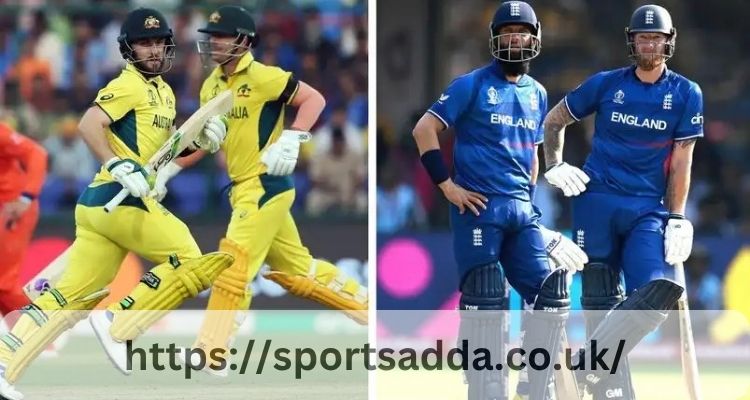Australia and England matches are filled with nail-biting drama. From Ashes series to high-scoring ODIs, their contests showcase both teams’ immense talent and history.
From magnificent centuries to exciting spells and game-altering catches to heart-stopping finishes, this match had it all!
In this article, we will discuss the main points or high lights of England Cricket Team vs Australian Men’s Cricket Team Match Scorecard.
Here are the last 5 men’s international matches between England 🇬🇧 and Australia 🇦🇺 (all formats), formatted in a table:
| Date | Format | Series/Tournament | Venue | Winner | Margin |
|---|---|---|---|---|---|
| 22 Feb 2025 | ODI | ICC Champions Trophy 2025 (Match 4, Group B) | Lahore, Pakistan | Australia | 5 wickets (chased 356) |
| 29 Sep 2024 | ODI | Australia tour of England 2024 (5th ODI) | Bristol, England | Australia | 49 runs (DLS) |
| 27 Sep 2024 | ODI | Australia tour of England 2024 (4th ODI) | Lord’s, England | England | 186 runs |
| 24 Sep 2024 | ODI | Australia tour of England 2024 (3rd ODI) | Chester-le-Street | England | 46 runs (DLS) |
| 28–31 Jul 2023 | Test | The Ashes 2023 (5th Test) | The Oval, England | England | 49 runs |
The Ashes
Few sporting rivalries can rival The Ashes in intensity and depth of history, with England often winning some of the most brutal bowling ever seen during this legendary series. One particularly memorable episode in 1932-33 involved England deliberately targeting fast deliveries at batters’ bodies instead of stumps in order to claim victory over an adversary that had experienced brutal bowling action from Australia and New Zealand.
England are set to make an attempt at reclaiming The Ashes since 2014 under world champion Australia but with Ben Stokes leading their side. Under his guidance, Australia have changed considerably from when they lost the last Test 4-0 down under.
England began their second innings with optimism as Zak Crawley and Ben Duckett made impressive starts, before rain came sabotaging their efforts and play was called off for the day. Joe Root and Ollie Pope remain in place with skipper Ben Stokes also showing signs of form as England seek to avoid another innings defeat against Australia. Australia may feel satisfied by how quickly their attack has depleted England’s top order; all that needs to happen for a series win on day four is limited damage from day three and four to make sure of a series win!
1953
The England Men’s Cricket Team represents England internationally and is currently managed by the England and Wales Cricket Board as an Associate Member of ICC with Test, One Day International (ODI), Twenty20 International (T20I), and Twenty20 International status. Based out of London with home matches held at Lord’s, prior to 1997 this team was known by its initial name of Marylebone Cricket Club or “MCC”.
Once they had returned from World War II, England experienced an unexpectedly successful return to Test cricket under Wally Hammond as captain and under his captaincy, they defeated India 3-1 in 1947-48 and South Africa 3-0 between 1954-55 and 1956-57 under Denis Compton, winning their first Ashes series since 19 years. Frank Tyson’s remarkable bowling figures of 9/90 at Sydney and 7/57 at Melbourne broke records on that tour as he set an England bowling record that remains today; unfortunately this success would soon fade and second Ashes defeat would occur two years later under Len Hutton’s captaincy.
1956
England and Australia continue their fierce rivalry in an array of unforgettable matches, featuring thrilling hitting and bowling performances that make their clash one of the greatest in cricket history.
After an initial batting collapse, England rallied to post 249 in their first innings and Australia responded by posting 457. In reply, England defeated Australia and set an enormous target. Although the first Test ended up as a draw, but the second resulted in an emphatic England win; even with rain-affected conditions impacting final Test, England held onto The Ashes.
As weather deteriorated rapidly on day 2, only three-quarters of an hour of play could take place; during that period Australia managed to score six runs while losing Burke.
As rain continued to pour down on an already soggy pitch, batting became difficult. Laker and Lock were introduced and quickly turned batting into an ordeal for Australia: Craig, Mackay and Sheppard all fell within nine overs for just 17 runs combined; only McDonald, unbeaten on 59 overnight, looked at ease against Laker and Lock. England’s openers looked impressive while they batted.
1961
As both teams’ top bowlers entered retirement, draws became increasingly common during the 1960s. Australia, led by Bob Simpson and Bill Lawry, employed more conservative batting tactics to preserve wickets, while England, without comparable quality bowlers of its own, struggled for results.
After an indecisive first Test at Lord’s, Australia led by 22 runs on day two before Jack Hobbs and Herbert Sutcliffe took their team up to 173 runs and secured an 18-17 advantage before rain stopped play for good.
The match was decided during the fourth and final Test at The Oval, when Australia batted first and posted an astounding 701 run score compared to England’s meager 266 run total in response. Australia won this series 2-1 with Richie Benaud taking 6-70 during English runchase attempts.
England bowlers Harold Larwood and Bill Voce contributed their victory by using “Bodyline tactics”, forcing Australian batsmen to defend themselves with bat, leaving them vulnerable to easy catches by an array of leg side fields. This tactic caused such outrage that diplomats had to intervene to preserve Anglo-Australian relations before eventually the MCC changed its laws against using such practices in cricket matches.
1985
It was the final tour of Bradman and his famed Invincibles. Playing to record crowds at Lord’s and Headingley, Australia produced astounding displays in both Tests to win both series 2-0 in England. Fred Spofforth struck a blow against English batsmen during their second innings of Test 4 while Richie Benaud took 6-70 during an English runchase to help seal an Australian series win of two-nil against them.
Still, concerns remained regarding Australia’s ability to cope with England’s challenging summer conditions and this led to numerous team alterations throughout the tour, such as replacing Bill Woodfull with Graeme Wood for the first Test, Allan Border replacing McCabe at number three batsman position, and Simon O’Donnell taking John Gilbert’s place for Test 5.
Even after some lackluster performances, Australia eventually won their inaugural Test through Allan Border and Graeme Woodfull’s dominant batting performances. They then went on to lose in three of four Tests before rallying to tie with an innings from Border and four five-wicket hauls from spinners Richard Hadlee and Andy Biddlecombe at draw number four.
1986-87
The initial Test can often set the tone for an entire series, and this match was no exception. Many observers, including Martin Johnson of The Independent, had noted that Mike Gatting’s England side “had only three things wrong – they couldn’t bat, bowl or field”.
English victory could not have come about without Ian Botham, however. His outstanding 138 in the first innings on an unforgiving Adelaide pitch with stands of 112 between Botham and Gatting was one of the finest pieces of batting seen for many years in world cricket.
Greg Chappell had chosen fast bowlers Bruce Reid and Chris Matthews (both from Western Australia) in order to take advantage of English batsmen’s problems against these types of bowlers. Unfortunately this proved an error: Matthews had been dropped from previous tours while Reid was relatively inexperienced. On the final day Botham smashed Brett Hutton for six over points before Peter Sleep bowled him – giving Sleep his only five wicket haul ever in Test cricket history.
2010-11
England and Australia enjoy one of the greatest rivalries in cricket, whether in an intense Test match or fiery one-day international under lights – never disappointing their fans in either form of contest. At Melbourne Cricket Ground (MCG), both sides put out all-out effort for The Ashes trophy that lies at stake here.
In the first over of the match, England struggle to make progress as they fail to capitalize on some loose bowling from Australia and fail to score runs quickly enough to score runs off it. Despite having plenty of opportunities, however, England are unable to capitalise and make significant headway.
Short finally hit his maiden ODI hundred with back-to-back sixes off Zampa to achieve it, as Australia were given just 57 to score off three overs before England had run out of wickets to defend. Short was not done there though and went on to hit two half volley sixes over mid on from Zampa before finally declaring with just under four overs remaining to bat in this ODI game.
England’s decision to reshuffle their batting order hasn’t paid dividends. Joe Root walked out at No. 3, only for his hesitation against Nathan Ellis’ quicks to cost him dearly when miscuing a short ball to mid-on and having it caught by Alex Carey for an easy catch from Alex Carey – then being bowled by Nathan Ellis for a golden duck, as they fail to convert their impressive score into a decisive win.


